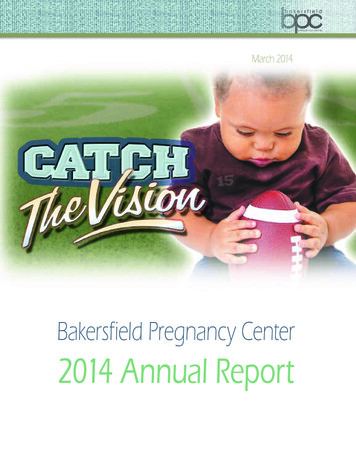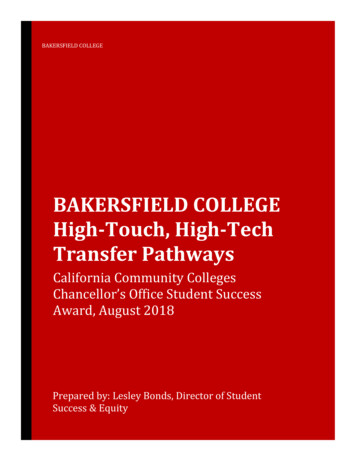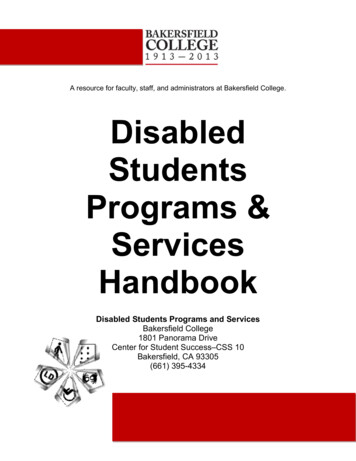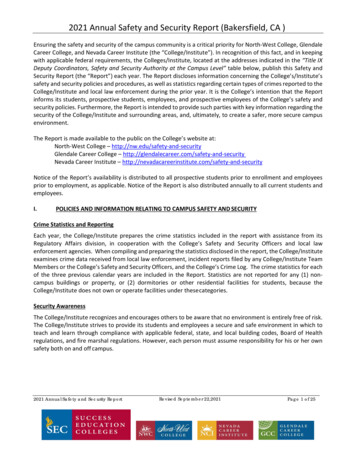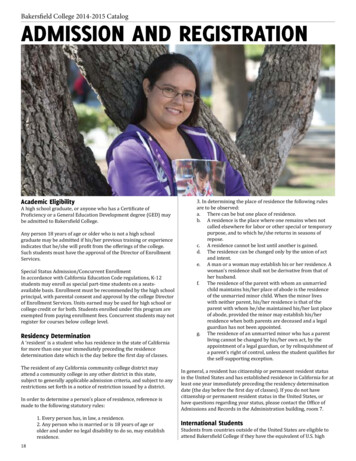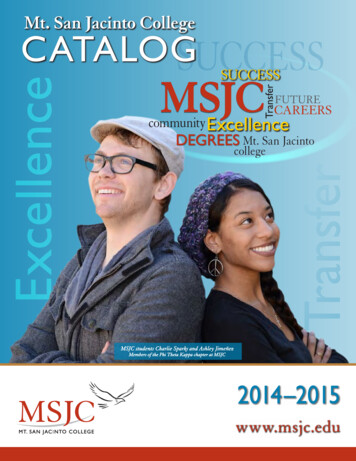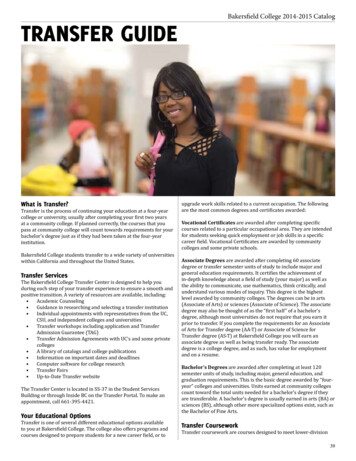
Transcription
TRANSFER GUIDEWhat is Transfer?Transfer is the process of continuing your education at a four-yearcollege or university, usually after completing your first two yearsat a community college. If planned correctly, the courses that youpass at community college will count towards requirements for yourbachelor’s degree just as if they had been taken at the four-yearinstitution.Bakersfield College students transfer to a wide variety of universitieswithin California and throughout the United States.Transfer ServicesThe Bakersfield College Transfer Center is designed to help youduring each step of your transfer experience to ensure a smooth andpositive transition. A variety of resources are available, including: Academic Counseling Guidance in researching and selecting a transfer institution Individual appointments with representatives from the UC,CSU, and independent colleges and universities Transfer workshops including application and TransferAdmission Guarantee (TAG) Transfer Admission Agreements with UC’s and some privatecolleges A library of catalogs and college publications Information on important dates and deadlines Computer software for college research Transfer Fairs Up-to-Date Transfer websiteThe Transfer Center is located in SS-37 in the Student ServicesBuilding or through Inside BC on the Transfer Portal. To make anappointment, call 661-395-4421.Your Educational OptionsTransfer is one of several different educational options availableto you at Bakersfield College. The college also offers programs andcourses designed to prepare students for a new career field, or toBakersfield College 2014-2015 Catalogupgrade work skills related to a current occupation. The followingare the most common degrees and certificates awarded:Vocational Certificates are awarded after completing specificcourses related to a particular occupational area. They are intendedfor students seeking quick employment or job skills in a specificcareer field. Vocational Certificates are awarded by communitycolleges and some private schools.Associate Degrees are awarded after completing 60 associatedegree or transfer semester units of study to include major andgeneral education requirements. It certifies the achievement ofin-depth knowledge about a field of study (your major) as well asthe ability to communicate, use mathematics, think critically, andunderstand various modes of inquiry. This degree is the highestlevel awarded by community colleges. The degrees can be in arts(Associate of Arts) or sciences (Associate of Science). The associatedegree may also be thought of as the “first half” of a bachelor’sdegree, although most universities do not require that you earn itprior to transfer. If you complete the requirements for an Associateof Arts for Transfer degree (AA-T) or Associate of Science forTransfer degree (AS-T) at Bakersfield College you will earn anassociate degree as well as being transfer ready. The associatedegree is a college degree, and as such, has value for employmentand on a resume.Bachelor’s Degrees are awarded after completing at least 120semester units of study, including major, general education, andgraduation requirements. This is the basic degree awarded by “fouryear” colleges and universities. Units earned at community collegescount toward the total units needed for a bachelor’s degree if theyare transferable. A bachelor’s degree is usually earned in arts (BA) orsciences (BS), although other more specialized options exist, such asthe Bachelor of Fine Arts.Transfer CourseworkTransfer coursework are courses designed to meet lower-division39
Bakersfield College 2014-2015 Catalog(freshman and sophomore) requirements of a four-year university.These courses can include transfer general education as well aspreparation-for-the major courses. Transfer coursework is the firststep to completing the bachelor’s and higher degrees.Choosing Your College MajorA major is a field of study that you emphasize in your collegeeducation. It is what you “specialize” in with your degree. It’simportant to remember that your major is what you will study at theuniversity you transfer to. At Bakersfield College, you can prepare totransfer into virtually any major at any university-there are literallythousands to choose from. To narrow down the options, studentsoften begin to select their major by one of the following techniques: If you have an idea of a career field you want to enter, youcan find majors that are related to, or prepare for, that careerfield. Majors and career fields are not always “perfectlymatched.” However, knowing your intended career field canhelp narrow your options. To research possible career pathways, visit the Virtual BCCareer Center, r/ or www.cacareercafe.com/or you can takeStudent Development B2, a career decision making course atBakersfield College. If you know what university you want to attend, you canselect from the list of majors at that university. Lists of majorsat California state universities are available at www.assist.org(click on “Explore Majors”). If you think you might be interested in a particular majorbut you are not sure, try taking a general education classin the major and see how you like it. Students often selecttheir major based simply on the courses that are the mostinteresting to them. For a description of the most popular majors in California,visit ors-west.aspxAssociate Degrees for TransferCalifornia Community Colleges are now offering associate degreesfor transfer to the CSU. These may include Associate in Arts (AA-T)or Associate in Science (AS-T) degrees. These degrees are designedto provide a clear pathway to a CSU major and baccalaureatedegree. California Community College students who are awardedan AA-T or AS-T degree are guaranteed admission with juniorstanding somewhere in the CSU system and given priority admissionconsideration to their local CSU campus or to a program that isdeemed similar to their community college major. This priority doesnot guarantee admission to specific majors or campuses.Students who have been awarded an AA-T or AS-T are ableto complete their remaining requirements for the 120-unitbaccalaureate degree within 60 semester or 90 quarter units.To view the most current list of Bakersfield College AssociateDegrees for Transfer and to find out which CSU campuses accepteach degree, please go to the Transfer portal on Inside BC. Currentand prospective community college students are encouraged to meetwith a counselor to review their options for transfer and to developan educational plan that best meets their goals and needs.40Choosing Your Transfer UniversityEach university may have different transfer requirements, sochoosing a transfer university (or a first, second, and third choice)is important to ensure you complete the right courses. Universitiesin the United States are organized into different systems andcategories. Choosing a transfer university is important because: The majors offered at each university are different. Each university has unique features, including factors like itsstudent body, its location, and its extracurricular activities. You are more likely to do well academically in a universityenvironment that you enjoy.The most common universities that Bakersfield College studentstransfer to include:University of California (UC)The UC combines undergraduate education (leading to a Bachelor’sdegree) with emphasis on graduate programs (Master and DoctorDegrees) and research. The tuition is relatively inexpensive forCalifornia residents. UC Davis, Merced and Santa Barbara are threeuniversities that BC students transfer to.UC Minimum RequirementsTransfer students will be eligible for admission if they meet thefollowing requirements: Complete a minimum of 60 UC-transferable semester units or90 UC-transferable quarter units. Obtain a minimum 2.4 GPA (2.8 for California non-residents).The GPA for admission may be significantly higher due to thedepartment or major applicant pool. Complete two transferable college courses in Englishcomposition and one transferable college course inmathematical concepts and quantitative reasoning. Complete 4 transferable college courses chosen from at leasttwo of the following subject areas: arts and humanities, socialand behavioral sciences, physical and biological sciences.The UC gives high priority to students who complete majorcoursework early in their academic career.Students who complete the Intersegmental General EducationTransfer Curriculum (IGETC) pattern prior to transferring to the UCsystem will meet the transfer eligibility coursework requirementlisted above (for details on IGETC, see appropriate section of thisguide for details). Students are strongly recommended to meet witha counselor to discuss additional requirements for competitiveadmissions based on major and campus choice.California State University (CSU)Emphasizes undergraduate education (leading to a bachelor’sdegree) but also offers master’s degrees. Professors spend moretime in the classroom and less time on research than those inthe University of California system. CSUs emphasize preparationfor specific careers and are relatively inexpensive for Californiaresidents. CSU Bakersfield, Fresno State University and CSUNorthridge are three local universities in the 23-campus CaliforniaState University system that BC students transfer to.CSU Minimum Admission RequirementsTransfer students will be eligible for admission if they meet thefollowing requirements: Complete a minimum of 60 CSU-transferable semester units
Bakersfield College 2014-2015 Catalog or 90 CSU-transferable quarter units.Obtain a minimum 2.0 GPA (2.4 for California non-residents).Impacted majors, programs and colleges may have higherGPA requirements.Complete the “Golden Four” (Oral Communication, WrittenCommunication, Critical Thinking, and Mathematics/Quantitative Reasoning) with a grade of C or better. Pass/NoPass grades are not recommended in these areas.Students are urged to complete a General Education Pattern in itsentirety as CSU GE or IGETC (see appropriate section of this guidefor details).Students are strongly recommended to meet with a counselor todiscuss additional requirements for competitive admissions basedon major and campus choice.Private Colleges and UniversitiesPrivate colleges and universities are colleges and universitiesthat are not funded by public taxes, and are sometimes called“independent.” Each university is unique with its own programs,majors, and degrees. Some offer academic programs grounded in aspecific religion or philosophy. Others offer programs in only onediscipline, such as the arts or technical degrees. Others specialize inproviding continuing education to working adults. Usually smallerand more focused in academic emphasis than public universities.Historically Black Colleges and Universities (HBCUs)Usually have a majority African-American student body, althoughstudents of all races attend them. They may be private or out-of-statepublic schools. Most are located in the southern United States.Hispanic Serving InstitutionsThe Hispanic Association of Colleges and Universities (HACU) isa national educational association that represents colleges anduniversities committed to Hispanic Higher education success in theUnited States (including Puerto Rico), Latin America, and Spain.HACU has 193 member Hispanic-Serving Institutions (HSIs) locatedin 11 U.S. states and Puerto Rico. To be considered a HispanicServing Institution, the Hispanic enrollment at a college or universitymust be at least 25 per cent of the total student enrollment.California is home to 54 Hispanic Serving Institutions includingBakersfield College.Tribal Colleges and UniversitiesThere are 35 recognized Tribal Colleges and Universities inthe United States. These are located mainly in the Midwest andSouthwest. Tribal Colleges and Universities serve approximately30,000 full and part-time students. They offer two-year associatedegrees in over 200 disciplines with some providing a bachelor’s andmaster’s degree. They also offer 200 vocational certificate programs.Out-of-State Colleges and UniversitiesThese colleges include those colleges and universities that are notin California. They may be public or private and are usually moreexpensive for out-of-state residents than those who live and paytaxes in the state. This group of colleges offers a huge variety ofdegrees and graduate programs.Preparation for Major CoursesFor each major at a four-year institution, there are lower division(freshman and sophomore level) preparatory courses designedto prepare students for upper division study (junior and seniorlevel). Based on the availability of courses, students are stronglyencouraged to complete as many major prerequisite courses aspossible prior to transfer.Preparation for Major courses for UC and CSU schools can be foundon ASSIST www.assist.org . The ASSIST website is designed toprovide students with the most accurate and up-to-date informationavailable. ASSIST lists which community college courses areequivalent to their four-year counterparts and/or will meet specificrequirements. Students can also get valuable information such asadditional screening requirements, if the major is impacted, and ifthere is a required GPA for a specific major on ASSIST.For students looking to transfer to a private/independent or out-ofstate school, you should first access the Bakersfield College TransferCenter portal on Inside BC or talk to a Counselor to find out ifBakersfield College has an articulation agreement with your schoolof interest.If Bakersfield College has no articulation with the school, you shouldgo to the school’s undergraduate admissions page and search fortransfer information or contact the school’s admissions departmentdirectly to find out the best way you can take courses towards majorpreparation.General Education CoursesGeneral Education (GE) is a set of courses from a variety of differentsubject areas that every student must complete in order to earn abachelor’s degree, regardless of major. The goal is to provide a wellrounded or “liberal” education and develop the knowledge, skills,and attitudes that together help make up an “educated person”.The completion of GE prior to transfer is not required for admissionto most universities. However, it is usually in the students’ bestinterest to complete an appropriate transfer GE pattern at thecommunity college. This is because GE requirements that are notfulfilled prior to transfer must be completed later at the university,which often extends the time and expense of a university education.Students usually follow one of three transfer GE options. These are:The IGETC pattern (see page 41)IGETC is accepted by all CSU campuses and most UC campuses andmajors. It is also accepted by some private/independent or out-ofstate universities.The CSU GE pattern (see page 42)CSU GE is accepted by all CSU campuses and some private/independent or out-of-state universities. It is not accepted by the UCsystem.An alternative general education pattern (see page 44)It is usually not recommended for students who plan to transferto the UC or CSU systems to follow this option. However, studentsentering high-unit majors such as science or engineering, thosetransferring to a private/independent or out-of-state institution, orthose who plan to apply to only one university may be best served byan alternative general education pattern.41
Bakersfield College 2014-2015 CatalogIt is strongly recommended that students consult with a counselor todetermine which general education pattern is most appropriate fortheir individual educational goals.Completion of the IGETC or CSU GE pattern also fulfills therequirements for General Education for a Bakersfield CollegeAssociate of Arts or Science degree. Students who complete one ofthese patterns and additional transfer coursework may also qualifyfor a Bakersfield College Liberal Arts degree.General Education Certification (GEC)General Education Certification is a legal agreement between theUC or CSU systems and the California Community Colleges thatpermits a student to transfer from a community college to a UC orCSU campus without the need to complete additional lower divisiongeneral education courses to satisfy university GE requirementsafter transfer. Bakersfield College will provide an IGETC or CSU GEcertification upon completion of GE coursework when requestedby the student on the transcript form. This certification mayinclude selected courses taken from other regionally accreditedcolleges, or credit earned through other means, such as AdvancedPlacement (AP) test credit. Students do not have “catalog rights”to a certification pattern. Certification is subject to the followingconditions: For full certification, no fewer than 39 units will be certified;for partial certification, now fewer than 24 units will becertified; Only entire areas will be certified.Pass Along CertificationStudents who transfer credits from another California communitycollege often want to “pass along” the general educationcertifications that they have earned. Any California communitycollege may certify such coursework from another Californiacommunity college, from a regionally accredited college oruniversity, or from a CSU or UC campus. It is critically importantthat students transferring coursework from other colleges anduniversities, fill out the Request for Evaluation form available underAdmissions and Records, Other Forms on the BC website or atwindow #6 in the Office of Admissions and Records and that theyhave official transcripts sent to Bakersfield College Admissions andRecords Department to be evaluated.Course Identification Numbering System (C-ID)The Course Identification Numbering System (C-ID) is a statewidenumbering system independent from the course numbers assignedby local California community colleges. A C-ID number next to acourse signals that participating California colleges and universitieshave determined that courses offered by other California communitycolleges are comparable in content and scope to courses offeredon their own campuses, regardless of their unique titles or localcourse number. Thus, if a schedule of classes or catalog lists a coursebearing a C-ID number, for example COMM 110, students at thatcollege can be assured that it will be accepted in lieu of a coursebearing the C-ID COMM 110 designation at another communitycollege. In other words, the C-ID designation can be used to identifycomparable courses at different community colleges. However,students should always go to www.assist.org to confirm how eachcollege’s course will be accepted at a particular four-year college oruniversity for transfer credit.42The C-ID numbering system is useful for students attendingmore than one community college and is applied to many of thetransferable courses students need as preparation for transfer.Because these course requirements may change and because coursesmay be modified and qualified for or deleted from the C-ID database,students should always check with a counselor to determine howC-ID designated courses fit into their educational plans for transfer.Students may consult the ASSIST database at www.assist.org forspecific information on C-ID course designations. Counselors canalways help students interpret or explain this information.Intersegmental General Education Transfer Curriculum(IGETC)About the IGETC PatternThe Intersegmental General Education Transfer Curriculum (IGETC)is a general education pattern that will fulfill all lower divisiongeneral education requirements at all California State University(CSU) campuses and most University of California (UC) campuses/majors. It is also accepted by some private/independent or out-ofstate universities. IGETC is usually recommended for students whointend to transfer to a UC campus, or who are not yet sure of theirintended transfer university. Completion of the IGETC pattern is notan admission requirement for transfer to most UC or CSU campuses,nor is it the only way to fulfill the lower division GE requirements ofa UC or CSU campus prior to transfer.It is strongly recommended that students consult with a counselor todetermine which general education pattern is most appropriate fortheir individual educational goals.Rules for using the IGETC pattern Each course must have been IGETC approved at the time itwas taken. See www.assist.org for a list of certified coursesand approval dates. Courses may be approved for more than one IGETC area.However, each course may be used to certify only one of theareas it is approved for. Students should apply for IGETC certification at the lastcommunity college attended prior to transfer. Forms areavailable under Admissions and Records, Other Forms or atWindow 6 in the Office of Admissions and Records. AP credit and coursework completed at accredited U.S.colleges and universities may be used to fulfill some IGETCrequirements. All such credit must be evaluated throughAdmissions and Records. Foreign coursework is notacceptable. All courses must be passed with a “C” or higher, “C-“ is notacceptable. Students transferring to UC need not complete the OralCommunication requirement (Area 1C). Students transferring to CSU need not complete theLanguages Other than English requirement. Some UC campuses do not allow use of IGETC for studentswho were previously enrolled at a UC campus. Some community college courses have limitations on theamount of credit awarded by the receiving university. See acounselor, the course description in the college catalog, orwww.assist.org for more information.
Bakersfield College 2014-2015 CatalogIGETC is NOT recommended for the following transfer destinations UC San Diego Revelle and Eleanor Roosevelt Colleges UC Berkeley Colleges of Business, Chemistry, EnvironmentalDesign (Architecture), Engineering, Natural Resources,Optometry. UC Davis College of Engineering UC Irvine Schools of Engineering, Biological Sciences, PhysicalSciences UC Riverside Colleges of Engineering, Natural andAgricultural Sciences UC Santa Barbara Colleges of Engineering, Creative Studies UC Los Angeles Schools of Engineering and Applied ScienceThe IGETC PatternArea 1English Communication: A minimum of nine units required; chooseone from each group. Note: Students transferring to the University ofCalifornia do not have to meet the oral communication requirementor the unit requirement of Area 1.Group AEnglish Composition: one course, three semester/four to fivequarter units.ENGL B1aGroup BCritical Thinking-English Composition: one course, threesemester/four to five quarter units. Courses must have EnglishComposition as a prerequisite. AP credit may not be used.ENGL B2, B3; PHIL B9Group COral Communication: one course, three semester/four to fivequarter units.COMM B1, B2, B4, B8Area 2Mathematical Concepts and Quantitative Reasoning: one course,three semester/4-5 quarter units.MATH B1a, B1b, B2, B6a, B6b, B6c, B6d, B6e, B22, B23, PSYC B5Area 3Arts and Humanities: At least three courses, nine semester/12-15quarter units. At least one course from the arts and one from thehumanities.A. Arts:ART B1, B2, B4, B35, B36, B37MUSC B2, B4a, B4b, B21a, B21b, B22, B23, B27THEA B12a, B20, B31, B32B. Humanities:ASL B2, B3ENGL B1b, B5a, B5b, B10, B21, B24, B27, B28, B30a, B30bHIST B1, B2, B4a, B4b, B15, B17a , B17b, B18, B20a, B20b,B25, B30a, B30b, B36JAPN B2MUSC B24PHIL B6a, B10, B18, B32, B33, B37SPAN B3, B4Area 4Social and Behavioral Sciences: At least three courses, ninesemester/12-15 quarter units. Courses from at least two disciplinesor an interdisciplinary sequence.ANTH B2, B3, B5CHDV B21COMM B6ECON B1, B2GEOG B2HIST B1, B2, B4a, B4b, B15, B17a, B17b, B18, B20a, B20b,B25, B30a, B30b, B36JRNL B1POLS B1, B2, B3, B16PSYC B1a, B6, B20, B33, B40SOCI B1, B2, B20, B28, B36, B45Area 5Physical and Biological Sciences: The IGETC physical and biologicalscience area requires a minimum of two courses, one physicalscience and one biological science course and at least one of the twomust include a laboratory, seven to nine semester/nine to twelvequarter units. Physical and biological science courses that include alaboratory component are listed below in C.A. Physical Sciences:ASTR B1, B2, B3CHEM B1a, B2a, B11, B18ERSC B10GEOG B1, B3GEOL B10, B11PHYS B2a, B4aB. Biological Sciences:ANTH B1BIOL B3a, B3b, B7, B11, B16, B20B32, B33CRPS B10PSYC B1bC. Laboratory Science:BIOL B3a, B3b, B7, B11, B16, B20, B32, B33CHEM B1a, B2a, B11, B18CRPS B10ERSC B10LGEOG B1LGEOL B10L, B11LPHYS B2a, B4aArea 6-Language Other than EnglishUC Requirement Only. In order to complete IGETC for the Universityof California system, students are required to demonstratecompetence/proficiency in a language other than English equal totwo years of high school study. Competence may be demonstratedthrough the following mechanisms:1. Completion of two years of the same foreign language of highschool level work with grades of “C” or better;2. Completion of a course or courses at a college or university,with a grade of “C” or better in each course. Usually, onesemester of college work in a language other than English isequivalent to two years of high school work;Any one of the following course or courses completed with a gradeof “C” or better will fulfill the requirement.43
Bakersfield College 2014-2015 Catalog6A: Languages Other Than EnglishASL B1American Sign Language 1ASL B2American Sign Language 2ASL B3American Sign Language 3ASL B4American Sign Language 4JAPN B1Elementary JapaneseJAPN B2Elementary JapaneseSPAN B1Elementary Spanish ISPAN B2Elementary Spanish IISPAN B3Intermediate Spanish ISPAN B4Intermediate Spanish IISPAN B35Spanish for Heritage Speakers ISPAN B36Spanish for Heritage Speakers II3.Achieve a satisfactory score on the SAT Subject test inlanguages other than English, as listed below. If the test wastaken before May 1995, the first score is the minimum; ifthe test was taken after May 1995, the second score is theminimum: Chinese With Listening: not offered before 1995/520 French/French With Listening:500/540 German/German With Listening:500/510 Hebrew (Modern):500/470 Italian:500/520 Japanese With Listening:500/510 Korean/Korean With Listening: not offered before1995/500 Latin:500/530 Spanish/Spanish With Listening:500/5204. Achieve a score of 3,4 or 5 on a College Board AdvancedPlacement (AP) Examination in a language other than English.5. Achieve a score of 5 or higher on an InternationalBaccalaureate (IB) Higher level Examination in a languageother than English.6. Complete, with grades of C or better, two years of formalschooling at the sixth-grade level or higher in an institutionwhere the language of instruction is not English. If secondaryschool was completed in a non-English-speaking countryand the language of instruction of the secondary school wasnot English, language other than English proficiency can becertified for IGETC without further evaluation. The studentmust present appropriate documentation of attendance at thesecondary school.7. Earn a passing grade on the international A level or O levelexam in a language other than English.8. If appropriate achievement test is not available to assertproficiency, have competency verified by a faculty memberassociated with a California community college. Suchverification requires that the college provide a documenton letterhead asserting that the student’s proficiency in thelanguage is equivalent to two years of high school study. Seea counselor for more information. Only students who haveno other means to verify foreign language proficiency maypursue this option. Students must petition for faculty memberverification through the Evaluations office.9. A Defense language Institute language other than Englishcourse which is indicated as passed with a “C” or higher onthe official transcript.10. Completion of courses above proficiency level, with grades ofC or better, may also be used to meet the requirement.44California State University General Education Breadth(CSU GE)About the CSU GE PatternThe California State University General Education-Breadth (CSUGE) pattern is one option that allows California community collegetransfer students to fulfill the lower-division general educationrequirements of any California State University (CSU) campus.The curriculum consists of a 39-unit pattern with five areas ofconcentration described in the CSU GE pattern.For assistance in determining the most appropriate generaleducation program, consult a counselor.Certification of CSU GE RequirementsOfficial notification from a California community college that atransfer student has completed courses fulfilling lower-divisiongeneral education requirements occurs through a process of“certification.” Certification is a legal agreement between the CSUand California Community Colleges.It is the policy of Bakersfield College to provide certification ofgeneral education breadth requirements when such service isrequested by the student or whenever a student requests that atranscript be sent to a CSU or UC if the student has completed all of39 units for certification. Certification of general education coursesis generally requested when the CSU GE pattern has been completed.Additional CSU GE Information and Restrictions Completion of the CSU GE pattern is not an admissionrequirement nor does completion guarantee admission to anyCSU campus or program. Certification is based on approved courses listed in theBakersfield College CSU GE pattern or from other regionallyaccredited institutions. Courses taken at other communitycolleges must fulfill the appropriate GE breadth area asdefined by that college. Courses completed at a foreign college or university cannotbe used to satisfy requirements for certification. Catalog rights do not apply to the CSU GE pattern Prior to certification, students must complete a m
of Arts for Transfer degree (AA-T) or Associate of Science for Transfer degree (AS-T) at Bakersfield College you will earn an associate degree as well as being transfer ready. The associate degree is a college degree, and as such, has value for employment and on a resume. Bachelor's Degrees are awarded after completing at least 120

